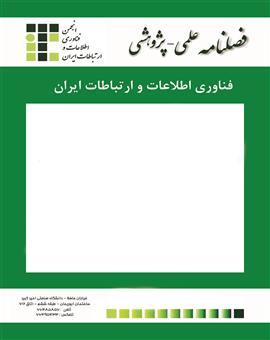ارائه الگوی معماری دانش منابع انسانی در سازمانهای دانشبنیان با استفاده از رویکرد آمیخته
محورهای موضوعی : عمومى
عبداله ساعدی
1
,
رضا سپهوند
2
![]() ,
سید نجم الدین موسوی
3
,
محمد حکاک
4
,
سید نجم الدین موسوی
3
,
محمد حکاک
4
1 - مدیریت منابع انسانی، دانشگاه لرستان، خرم آباد، ایران
2 - گروه مدیریت بازرگانی، دانشگاه لرستان، خرم آباد، ایران
3 - گروه مدیریت بازرگانی، دانشگاه لرستان، خرم آباد، ایران
4 - گروه مدیریت بازرگانی، دانشگاه لرستان، خرم آباد، ایران
کلید واژه: معماری دانش, معماری دانش منابع انسانی, رویکرد آمیخته, سازمان¬های دانش¬بنیان ,
چکیده مقاله :
معماری دانش منابع انسانی بیش از هر ابزار یا عنصر دیگری در شیوۀ ایجاد، سازماندهی کردن، اندوختن، توزیع و کاربرد دانش برای دستیابی به اهداف سازمانی ضروری است. پژوهش حاضر باهدف ارائه الگوی معماری دانش منابع انسانی در سازمان های دانش بنیان با استفاده از رویکرد آمیخته انجام پذیرفت. این پژوهش بر پایه پژوهشهای آمیخته و بهصورت کمی و کیفی است که ازنظر هدف، کاربردی و حیث ماهیت و روش، توصیفی پیمایشی است. جامعه آماری پژوهش حاضر را سازمان های دانش بنیان استان لرستان تشکیل می دهد که 30 نفر از خبرگان آنها بر اساس اصل کفایت نظری و با استفاده از روش نمونه گیری هدفمند انتخابشدهاند. ابزار گردآوری اطلاعات در بخش کیفی پژوهش، مصاحبه نیمه ساختاریافته و در بخش کمی نیز پرسشنامه است. در بخش کیفی، دادهها و اطلاعات با استفاده از نرمافزار Atlas.ti و روش کدگذاری تحلیل و شاخصهای معماری دانش منابع انسانی شناسایی شدند. در بخش کمی پژوهش، با استفاده از نرمافزار Matlab و روش مدلسازی ساختاری تفسیری مدل نهایی پژوهش تدوین و ارائهشده است. نتایج پژوهش دربرگیرنده شاخصها و مؤلفههای معماری دانش منابع انسانی و ارائه مدل معماری دانش منابع انسانی در سازمان های دانش-بنیان است. بدین ترتیب، یافته ها علاوه بر تدوین مدل معماری دانش منابع انسانی، حاکی از شناسایی مؤلفههای اصلی معماری دانش منابع انسانی، زیرساخت های مدیریت دانش، ویژگیهای حرفهای، ویژگیهای موقعیتی و دستاوردهای معماری دانش منابع انسانی است.
Knowledge architecture of human resources is more important than any other tool or element in the way of creating, organizing, storing, distributing and applying knowledge to achieve organizational goals. The present study was conducted to present the architectural model of human resource knowledge in knowledge-based organizations using a mixed approach. This research is based on mixed research and quantitatively and qualitatively, which is descriptive-survey in terms of purpose, application and nature and method. The statistical population of the present study consists of knowledge-based organizations in Lorestan province, 30 of whose experts have been selected based on the principle of theoretical adequacy and using purposive sampling. The data collection tool in the qualitative part of the research is a semi-structured interview and in the quantitative part is a questionnaire. In the qualitative section, data and information were identified using Atlas.ti software and analysis coding method and architectural indicators of human resource knowledge. In the quantitative part of the research, the final model of the research has been developed and presented using Matlab software and interpretive structural modeling method. The research results include the indicators and components of human resource knowledge architecture and the presentation of human resource knowledge architecture model in knowledge-based organizations. Thus, in addition to developing a human resource knowledge architecture architecture model, the findings indicate the identification of the main components of human resource knowledge architecture, knowledge management infrastructure, professional characteristics, situational characteristics and achievements of human resource knowledge architecture.
